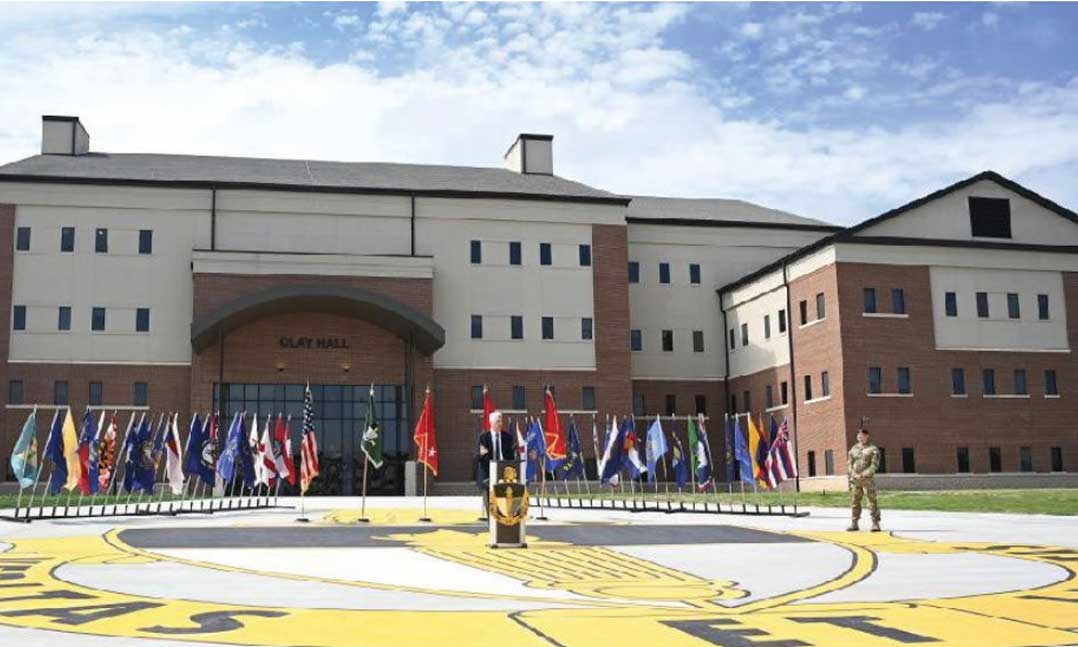Fort Bragg’s John F. Kennedy Special Warfare Center and School held a ribbon cutting ceremony in June for two buildings named in honor of two of the most famous Green Berets in Army history.
The North Carolina school’s newly opened Chapman Hall, which was named in honor of Army Sgt. 1st Class Nathan Chapman, will house advanced skills and network courses, as well as headquarters for six companies and five different training battalions, according to an Army statement.
The campus’s other new building, Volckmann Hall, is named in honor of Army Brig. Gen. Russell Volckmann.
 Retired Lt. Gen. Bennet Sacolick, former commander of the Army’s John F. Kennedy Special Warfare Center and School, speaks in front of the special warfare center on June 23 at North Carolina’s Fort Bragg. Officials at the school held a ribbon-cutting ceremony for the opening of Chapman Hall, named for Army Sgt. 1st Class Nathan Chapman, and Volckmann Hall, named for Army Brig. Gen. Russell Volckmann. Photo by US Army.According to the Army, Volckmann Hall will house the headquarters of the 1st Special Warfare Training Group (Airborne), the Army’s Warrant Officer Institute and the service’s Special Forces
Retired Lt. Gen. Bennet Sacolick, former commander of the Army’s John F. Kennedy Special Warfare Center and School, speaks in front of the special warfare center on June 23 at North Carolina’s Fort Bragg. Officials at the school held a ribbon-cutting ceremony for the opening of Chapman Hall, named for Army Sgt. 1st Class Nathan Chapman, and Volckmann Hall, named for Army Brig. Gen. Russell Volckmann. Photo by US Army.According to the Army, Volckmann Hall will house the headquarters of the 1st Special Warfare Training Group (Airborne), the Army’s Warrant Officer Institute and the service’s Special Forces
Officer Course.
AFGHANISTAN WAR’S FIRST KIA
Chapman was a Special Forces communications sergeant.
On Jan. 4, 2002, he was the first uniformed U.S. servicemember killed in the Afghanistan War. Chapman volunteered to be a part of the operation, according to official Army history. At the time, Chapman, an Ohio native, was a part of 3rd Bn., 1st Special Forces Group (Airborne).
Chapman, a career soldier, enlisted in the Army in 1988. He completed basic training and advanced individual training as an infantryman, as well as parachutist and Ranger training, at Georgia’s Fort Benning.
Chapman in 1989 participated in Operation Just Cause in Panama. He was assigned to A Co., 2nd Bn., 75th Ranger Regt. At the time, as a part of 3rd Bn, 47th Inf. Regt., Chapman participated in 1991’s Operation Desert Storm.
After returning stateside later that year, Chapman volunteered for Army Special Forces training, then graduated as a Green Beret in December 1992. As a Special Forces communications soldier, Chapman took part in the 1994-95 Operation Uphold Democracy in Haiti.
GREEN BERET FOUNDER
Volckmann — a graduate of the United States Military Academy in West Point, New York — is considered by many to be a “founding father” of Army Special Forces. The former Army flag officer fought in World War II and the Korean War.
In the early 1940s, Volckmann was a part of the Philippines campaign, including the Battle of Bataan.
After the war, the then-Army Chief of Staff Gen. Dwight D. Eisenhower directed Volckmann to write the Army’s first counterinsurgency doctrine due to his experience in guerrilla warfare of WWII.
Volckmann later became the executive officer of the Special Activities Group — Far East Command. As XO, he directed guerrilla missions behind North Korean lines.
After the Korean War, Volckmann retired in 1957. He died in 1982 in his home state of Iowa.
This article is featured in the 2022 November/December issue of VFW magazine, and was written by Dave Spiva, associate editor for VFW magazine.